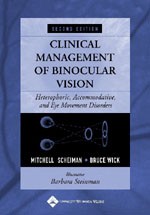This text serves as both a reference for ophthalmologists and a
required text for optometry students. It presents material by
diagnostic category, and for each category covers the background
information, symptoms, case analysis, and management options.
Case studies are included at the end of each chapter to further
emphasise application to clinical care. New features include the
revision of several chapters and the addition of three new
chapters on computers, acquired brain injury and learning
problems as they relate to vision disorders. References have
been updated and study questions added to the end of each
chapter.
DIAGNOSIS AND GENERAL TREATMENT APPROACH
Diagnostic Testing
Case Analysis and Classification
General Treatment Modalities, Guidelines, and Prognosis
II VISION THERAPY PROCEDURES AND INSTRUMENTATION
Introduction and General Concepts
Fusional Vergence, Voluntary Convergence, and Anti-suppression
Techniques
Accommodative Techniques
Ocular Motility Techniques
III MANAGEMENT
Low AC/A Conditions: Convergence Insufficiency and Divergence
Insufficiency
High AC/A Conditions: Convergence Excess and Divergence Excess
Normal AC/A Conditions: Fusional Vergence
Dysfunction, Basic Esophoria, and Basic Exophoria
Accommodative Dysfunction
Eye Movement Disorders
Cyclovertical Heterophoria
Fixation Disparity
IV ADVANCED DIAGNOSTIC AND MANAGEMENT ISSUES
Interactions Between Accommodation and Vergence
Refractive Amblyopia
Nystagmus
Aniseikonia
Binocular and Accommodative problems associated with computer use
Binocular and Accommodative problems associated with acquired
brain injury
Binocular and Accommodative problems associated with learning
problems
V VISION THERAPY AND OPTOMETRIC PRACTICE
Patient and Practice Management Issues in Vision Therapy
APPENDIXES
I Samples of Correspondence and Forms
II Sources of Additional Information
III Home Vision Therapy Procedures
INDEX


